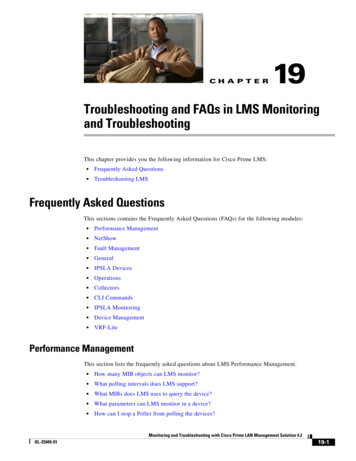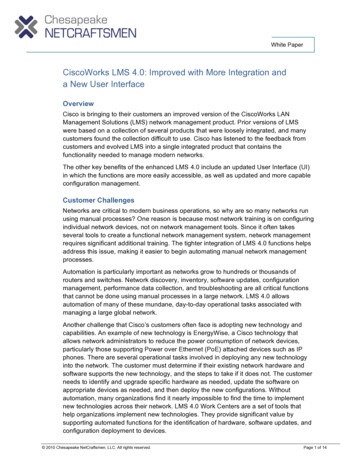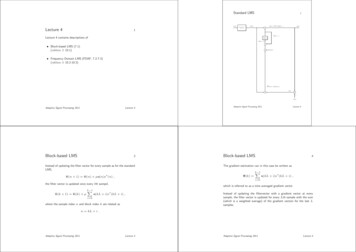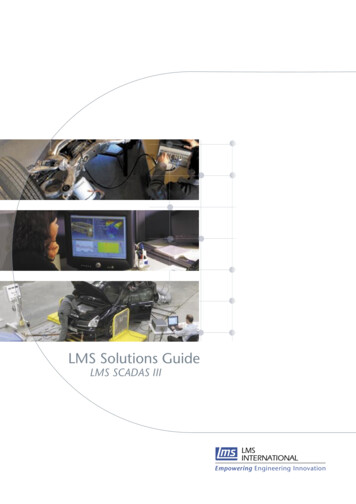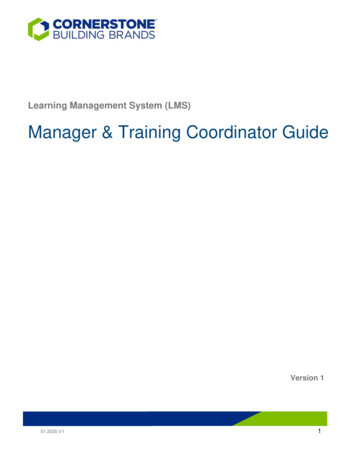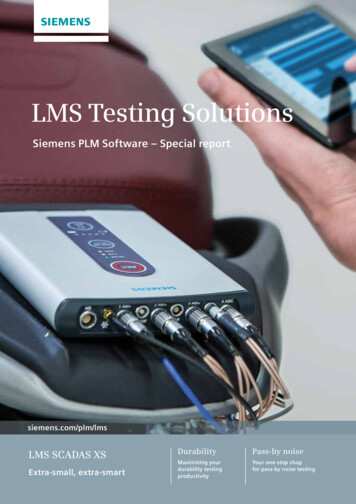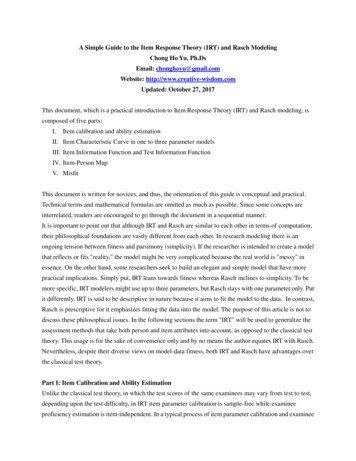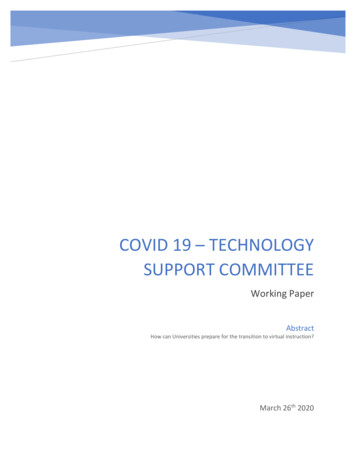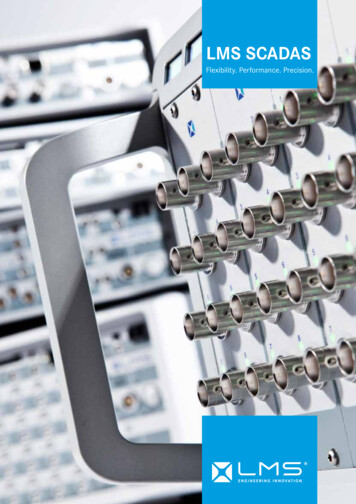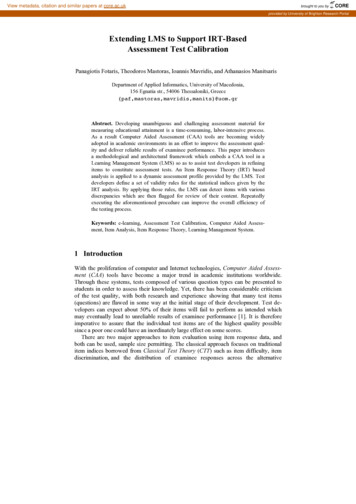
Transcription
View metadata, citation and similar papers at core.ac.ukbrought to you byCOREprovided by University of Brighton Research PortalExtending LMS to Support IRT-BasedAssessment Test CalibrationPanagiotis Fotaris, Theodoros Mastoras, Ioannis Mavridis, and Athanasios ManitsarisDepartment of Applied Informatics, University of Macedonia,156 Egnatia str., 54006 Thessaloniki, t. Developing unambiguous and challenging assessment material formeasuring educational attainment is a time-consuming, labor-intensive process.As a result Computer Aided Assessment (CAA) tools are becoming widelyadopted in academic environments in an effort to improve the assessment quality and deliver reliable results of examinee performance. This paper introducesa methodological and architectural framework which embeds a CAA tool in aLearning Management System (LMS) so as to assist test developers in refiningitems to constitute assessment tests. An Item Response Theory (IRT) basedanalysis is applied to a dynamic assessment profile provided by the LMS. Testdevelopers define a set of validity rules for the statistical indices given by theIRT analysis. By applying those rules, the LMS can detect items with variousdiscrepancies which are then flagged for review of their content. Repeatedlyexecuting the aforementioned procedure can improve the overall efficiency ofthe testing process.Keywords: e-learning, Assessment Test Calibration, Computer Aided Assessment, Item Analysis, Item Response Theory, Learning Management System.1 IntroductionWith the proliferation of computer and Internet technologies, Computer Aided Assessment (CAA) tools have become a major trend in academic institutions worldwide.Through these systems, tests composed of various question types can be presented tostudents in order to assess their knowledge. Yet, there has been considerable criticismof the test quality, with both research and experience showing that many test items(questions) are flawed in some way at the initial stage of their development. Test developers can expect about 50% of their items will fail to perform as intended whichmay eventually lead to unreliable results of examinee performance [1]. It is thereforeimperative to assure that the individual test items are of the highest quality possiblesince a poor one could have an inordinately large effect on some scores.There are two major approaches to item evaluation using item response data, andboth can be used, sample size permitting. The classical approach focuses on traditionalitem indices borrowed from Classical Test Theory (CTT) such as item difficulty, itemdiscrimination, and the distribution of examinee responses across the alternative
Extending LMS to Support IRT-Based Assessment Test Calibrationresponses. The second approach uses Item Response Theory (IRT) to estimate the parameters of an item characteristic curve which provides the probability that an item willbe answered correctly based on the examinee’s ability level as measured by the test.The natural scale for item difficulty in CTT is the percentage of examinees correctly answering the item. One term of item difficulty is p-value, which stands for theproportion of percentage of examinees correctly answering the item. Every item has anatural difficulty based on the performance of all persons undertaking the test; however, this p-value is quite difficult to estimate accurately unless a very representativegroup of test-takers is being tested. If for example the sample contains well instructed,highly able or highly trained people, then the test and its items will appear very easy.On the other hand, if the sample contains uninstructed, low-ability or untrainedpeople, then the same test will appear very hard. This is one of the main reasons thatCTT is often criticized for [2], [3], because the estimation of the p-value is potentiallybiased by the sample on which the estimate of item difficulty is based.With IRT the composition of the sample is generally immaterial, and item difficultycan be estimated without bias. The one-, two-, and three-parameter binary-scoring(dichotomous) IRT models typically lead to similar estimates of difficulty, and theseestimates are highly correlated to classical estimates of difficulty. Additionally, whileclassical statistics are relatively simple to compute and understand and do not requiresample sizes as large as those required by IRT statistics, they a) are not as likely to beas sensitive to items that discriminate differentially across different levels of ability(or achievement), b) do not work as well when different examinees take different setsof items, and c) are not as effective in identifying items that are statistically biased [4].As a result, the use of IRT models spread rapidly during the last 20 years and they arenow used in the majority of large-scale educational testing programs involving 500 ormost test-takers.IRT analysis yields three estimated parameters for each item, α, b and c respectively. The α parameter is a measure of the discriminating power of the item, the bparameter is an index of item difficulty, and the c is the “guessing” parameter, definedas the probability of a very low-ability test taker getting the item correct. A satisfactory pool of items for testing is one characterized by items with high discrimination (α 1), a rectangular distribution of difficulty (b), and low guessing (c 0.2) parameters[5], [6]. The information provided by the item analysis assists not only in evaluatingperformance but in improving item quality as well. Test developers can use theseresults to discriminate whether an item can be reused as is, should be revised beforereuse or should be taken out of the active item pool. What makes an item’s performance acceptable should be defined in the test specifications within the context of thetest purpose and use.Unfortunately only a few test developers have the statistical background needed tofully understand and utilize the IRT analysis results. Although it is almost impossibleto compel them to further their studies, it is possible to provide them with some feedback regarding the quality of the test items. This feedback can then act as a guide todiscard defective items or to modify them in order to improve their quality for futureuse. Based on that notion, the present paper introduces a comprehensible way to
P. Fotaris et al.present IRT analysis results to test developers without delving into unnecessary details. Instead of memorizing numerous commands and scenarios from technicalmanuals, test developers can easily detect problematic questions from the familiaruser interface of a Learning Management System (LMS). The latter can automaticallycalculate the limits and rules for the α, b, and c parameters based on the percentage ofquestions wanted for revision. The examinee’s proficiency (θ) is represented on theusual scale (or metric) with values ranging roughly between -3 and 3, but since thesescores include negative ability estimates which would undoubtedly confuse manyusers, they can optionally be normalized to a 0.100 range scale score.2 Related WorksThe use of Learning Management Systems (LMSs) and CAA tools has increasedgreatly due to the students’ demand for more flexible learning options. However, onlya small fraction of these systems supports an assessment quality control process basedon the interpretation of item statistic parameters. Popular e-learning platforms such asBlackboard [7], Moodle [8] and Questionmark [9] have plug-ins or separated modulesthat provide statistics for test items, but apart from that they offer no suggestions totest developers on how to improve the problematic items. Therefore, many researchers have recently endeavored to provide mechanisms for test calibration.Hsieh et al. introduced a model that presents test statistics and collects students’learning behaviors for generating analysis result and feedback to tutors [10]. Hung etal. proposed an analysis model based on CTT that collects information such as itemdifficulty and discrimination indices, questionnaire and question style etc. These dataare combined with a set of rules in order to detect defective items, which are signaledusing traffic lights [11]. Costagliola et al.’s eWorkbook system improved that idea byusing fuzzy rules to measure item quality, detect anomalies on the items, and giveadvice for their improvement [12]. Nevertheless, all of the aforementioned workspreferred CTT to IRT for ease of use without taking into consideration its numerousdeficiencies.On the other hand, IRT has been mainly applied in the Computerized Adaptive Test(CAT) domain for personalized test construction based on individual ability [13], [14],[15], [16], [17]. Despite its high degree of support among theoreticians and somepractitioners, IRT’s complexity and dependence on unidimensional test data and largesamples often relegate its application only to experimental purposes. While a literature review can reveal many different IRT estimation algorithms, they all involveheavy mathematics and are unsuitable for implementation in a scripting languagedesigned for web development (i.e. PHP). As a result, their integration in internetapplications such as LMSs is very limited. A way to address this issue is to have awebpage call the open-source analysis tool ICL to carry out the estimation processand then import its results for display. The present paper showcases a framework thatfollows the aforementioned method in order to extend an LMS with IRT analysisservices at no extra programming cost.
Extending LMS to Support IRT-Based Assessment Test Calibration3 Open-Source IRT Analysis Tool ICLSeveral computer programs that provide estimates of IRT parameters are currentlyavailable for a variety of computer environments [18], [19]. These include Rascal[20], Ascal [21], WINSTEPS [22], BILOG-MG [23], MULTILOG [24], PARSCALE[25], [26], RUMM [27] and WINMIRA [28] to name a few that are easily obtainable.Despite being the de facto standard for dichotomous IRT model estimation, BILOG isa commercial product and limited in other ways. Hanson provided an alternativestand-alone software for estimating the parameters of IRT models called IRT Command Language (ICL) [29]. A recent comparison between BILOG-MG and ICL [30]showed that both programs are equally precise and reliable in their estimations. However, ICL is a free, open-source licensed in a way that allows it to be modified andextended. In fact, ICL is actually IRT estimation functions (ETIRM) [31] embeddedinto a fully-featured programming language called TCL (“tickle”) [32] and thus allowing relatively complex operations. Additionally, ICL’s command line nature enables itto run in the background and produce analysis results in the form of text files. Sincethe proposed framework uses only a three-parameter binary-scoring IRT model (3PL),ICL proves more than sufficient for our purpose and was therefore selected to complement the LMS for assessment test calibration.4 Integrating IRT Analysis in Dokeos LMSDokeos is an open-source LMS accompanied by Free Software Foundation's [33] [34]General Public License [35]. It is implemented in PHP and requires Apache acting asa web server and mySQL as a Database Management System. Dokeos has been serving the needs of two academic courses at the University of Macedonia for over fouryears, receiving satisfactory feedback from both instructors and students. In order toextend its functionality with IRT analysis and assessment test calibration functions,we had to modify the source code so as to support the following features:1.2.3.4.After completing a test session, the LMS stores in its database the examinee’s response to each test item instead of keeping only a final score by default.Test developers define the acceptable limits for the following IRT analysisparameters: a) item discrimination, b) item difficulty, and c) guessing. TheLMS stores these values as validity rules for each assessment. There is anadditional choice of having these limits set automatically by the system inorder to rule out a specific percentage of questions (Fig. 1.1).Every time the LMS is asked to perform an IRT analysis, it displays a pagewith the estimated difficulty, discrimination and guessing parameters foreach assessment item. If the latter violates any of the validity rules alreadydefined in the assessment profile, it is flagged for review of its content (Fig.1.2). Once item responses are evaluated, test developers can discard, reviseor retain items for future use.In addition to a total score, the assessment report screen displays the proficiency θ per examinee as derived from the IRT analysis (Fig. 1.3).
P. Fotaris et al.Fig. 1. Functionality features supported in extended Dokeos LMS5 The Proposed Item Analysis MethodologyThe proposed methodology consists of four steps, with each one of them being anaction performed by the LMS. Although we used Dokeos as our LMS of choice, theproposed item analysis methodology can be applied to other e-learning tools, too.Once an update of the IRT results is called for, the LMS exports the proper data filesand TCL scripts (Fig. 3). The LMS then performs a number of calls to the ICL usingPHP (Fig. 4 and 5) and after parsing the analysis results, it imports them to its database. A system following this approach is illustrated in Fig. 2.
Extending LMS to Support IRT-Based Assessment Test CalibrationFig. 2. System architectureThe proposed methodology consists of the following steps:1.2.3.4.The LMS exports the assessment results to a data file and generates a TCLscript to process them (parameter estimation script). The bold parts in thescript change after each execution, depending on the number of the test itemsand the assessment name (e.g. 40 and test0140 respectively). The rest of thescript is about the algorithm performed by the ICL (“EM” algorithm), the typeof IRT analysis (dichotomous) and the maximum number of iterations (200).The LMS then calls up ICL with the parameter estimation script passed as aparameter in order to create a data file containing the α, b, and c values foreach test item. At the same time it prepares a second TCL script to processthese IRT parameters (θ estimation script).The LMS calls up ICL with the θ estimation script passed as a parameter soas to make a data file with the examinees’ θ values.Finally, the LMS imports the two ICL-produced data files (*.par and *.theta)to its database for further processing in the context of the aimed assessmenttest calibration.Once an initial item pool has been calibrated, examinees can then be tested routinely.As time goes on, it would almost surely become desirable to retire items that areflawed, have become obsolete, or have been used many times, and to replace themwith new items. Having these problematic items already been detected by the LMS,test developers can take any necessary course of action to improve the quality of tests.Additionally, since the limits for the IRT analysis parameters are not hard-coded, testdevelopers can modify them at will in order to tune the sensitivity of the system.
P. Fotaris et 01000110000001000000110. one row per examinee output -no printallocate items dist 40read examinees test0140.dat 40i1starting values dichotomousEM steps -max iter 200print -item paramrelease items distFig. 3. (a) Assessment results (test0140.dat file). (b) Parameter Estimation Script (test0140.tclfile).1 1,5975971,5067280,1285152 1,377810-0,876164 0,2239033 1,2584610,5493620,1405934 1,0318560,4956420,0792795 1,0778311,0044370,1363246 0,4791511,5442180,2182707 1,4392411,2793520,0823828 0,8982591,3102150,1295709 1,8375141,3495200,03267510 0,4676940,9342070,20608511 0,6076030,2655240,18121212 0,2400091,0543010,24573713 0,9456311,4514640,050895.item one row peroutput -no printallocate items dist 40read examinees test0140.dat 40i1read item param test0140.parset estep [new estep]estep compute estep 1 1delete estep estepset eapfile [open test0140.theta w]for {set i 1} { i [num examinees]} {incr i} {.}close eapfilerelease items distFig. 4. (a) Estimated parameters (test0140.par file). (b) θ estimation script (test0140t.tcl 0,66695412. one row per examinee Fig. 5. Estimated theta (test0140.theta file)
Extending LMS to Support IRT-Based Assessment Test Calibration6 ConclusionThe present paper introduced a methodological and architectural framework for extending an LMS with IRT–based assessment test calibration. Instead of having webdevelopers implement complex IRT estimation algorithms within the LMS, the proposed methodology uses ICL to obtain reliable IRT analysis results. The latterare then automatically imported to the LMS, thus releasing test developers of thisburdensome duty. By applying a set of validity rules, the enhanced LMS is able todetect several defective items which are then reported for review of their content. As aresult, the suggested approach is capable of assisting test developers in their continuous effort to improve flaws test items. Moreover, the user-friendly interface allowsusers with no previous expertise in statistics to comprehend and utilize the IRT analysis results.According to research focused on IRT sample size effects [36], a great number ofexaminees are needed to obtain accurate results. For example, Swaminathan and Gifford [37] concluded that about 1,000 examinees are required when using the 3PLmodel. This would pose a problem for most test developers due to the fact that thenumber of examinees in academic courses rarely exceeds 150. Nevertheless, less accurate estimates are acceptable when aiming for assessment calibration since the desired goal is to identify test items with the highest and lowest parameter values.The proposed system introduces a feature that addresses the aforementioned issue(Fig. 1.1) and allows test developers to easily pinpoint this particular group of testitems for revision.This initial experiment produced encouraging results, showing that the system caneffectively evaluate item performance and therefore increase the overall validity ofthe testing process. The fact that the proposed methodology is not limited to Dokeosbut can be easily adopted by different e-learning environments makes it especiallysuitable for academic use.References1. Haladyna, T.M.: Developing and Validating Multiple-Choice Test Items, 2nd edn. Lawrence Erlbaum Associates, Mahwah (1999)2. Hambleton, R.K., Jones, R.W.: Comparison of Classical Test Theory and Item Response3.4.5.6.7.8.Theory and their Applications to Test Development. Educational Measurement: Issues andPractices 12, 38–46 (1993)Hambleton, R.K., Swaminathan, H.: Item Response Theory: Principles and Applications.Kluwer-Nijhoff Publishing, Boston (1987)Schmeiser, C.B., Welch, C.J.: Test Development. In: Brennan, R.L. (ed.) EducationalMeasurement, 4th edn. Praeger Publishers, Westport (2006)Flaugher, R.: Item Pools. In: Wainer, H. (ed.) Computerized Adaptive Testing: A Primer,2nd edn. Lawrence Erlbaum Associates, Mahwah (2000)Baker, F.B.: Item Response Theory: Parameter Estimation Techniques. Marcel Dekker,New York (1992)Moodle.org: Open-source Community-based Tools for Learning,http://moodle.org/Blackboard Home, http://www.blackboard.com
P. Fotaris et al.9. Questionmark.Getting Results, http://www.questionmark.com10. Hsieh, C., Shih, T.K., Chang, W., Ko, W.: Feedback and Analysis from Assessment 26.27.28.data in E-learning. In: 17th International Conference on Advanced Information Networking and Applications (AINA 2003), pp. 155–158. IEEE Computer Society, Los Alamitos(2003)Hung, J.C., Lin, L.J., Chang, W., Shih, T.K., Hsu, H., Chang, H.B., Chang, H.P., Huang,K.: A Cognition Assessment Authoring System for E-Learning. In: 24th InternationalConference on Distributed Computing Systems Workshops (ICDCS 2004 Workshops), pp.262–267. IEEE Computer Society, Los Alamitos (2004)Costagliola, G., Ferrucci, F., Fuccella, V.: A Web-Based E-Testing System SupportingTest Quality Improvement. In: Leung, H., Li, F., Lau, R., Li, Q. (eds.) ICWL 2007. LNCS,vol. 4823, pp. 264–275. Springer, Heidelberg (2008)Wu, I.L.: Model management system for IRT-based test construction decision support system. Decision Support Systems 27(4), 443–458 (2000)Chen, C.M., Duh, L.J., Liu, C.Y.: A Personalized Courseware Recommendation SystemBased on Fuzzy Item Response Theory. In: IEEE International Conference on eTechnology, e-Commerce and e-Service, pp. 305–308. IEEE Computer Society Press,Los Alamitos (2004)Ho, R.G., Yen, Y.C.: Design and Evaluation of an XML-Based Platform-IndependentComputerized Adaptive Testing System. IEEE Transactions on Education 48(2), 230–237(2005)Sun, K.: An Effective Item Selection Method for Educational Measurement. In: AdvancedLearning Technologies, pp. 105–106 (2000)Yen, W., Fitzpatrick, A.R.: Item Response Theory. In: Brennan, R.L. (ed.) EducationalMeasurement, 4th edn. Praeger Publishers, Westport (2006)Kim, S., Cohen, A.S.: A Comparison of Linking and Concurrent Calibration under ItemResponse Theory. Applied Psychological Measurement 22(2), 131–143 (1998)Embretson, S.E., Reise, S.P.: Item Response Theory for Psychologists. Lawrence Erlbaum,Mahwah (2000)Assessment System Corporation: RASCAL (Rasch Analysis Program). Computer Software, Assessment Systems Corporation, St. Paul, Minnesota (1992)Assessment System Corporation: ASCAL (2- and 3-parameter) IRT Calibration Program.Computer Software, Assessment Systems Corporation, St. Paul, Minnesota (1989)Linacre, J.M., Wright, B.D.: A user’s guide to WINSTEPS. MESA Press, Chicago (2000)Zimowski, M.F., Muraki, E., Mislevy, R.J., Bock, R.D.: BILOG-MG 3: Multiple-groupIRT analysis and test maintenance for binary items. Computer Software, Scientific Software International, Chicago (1997)Thissen, D.: MULTILOG user’s guide. Computer Software, Scientific Software International, Chicago (1991)Muraki, E., Bock, R.D.: PARSCALE: IRT-based Test Scoring and Item Analysis forGraded Open-ended Exercises and Performance Tasks. Computer Software, ScientificSoftware International, Chicago (1993)du Toit, M. (ed.): IRT from SSI. Scientific Software International. Lincolnwood, Illinois(2003)Andrich, D., Sheridan, B., Luo, G.: RUMM: Rasch Unidimensional Measurement Model.Computer Software, RUMM Laboratory, Perth, Australia (2001)von Davier, M.: WINMIRA: Latent Class Analysis, Dichotomous and Polytomous RaschModels. Computer Software, Assessment Systems Corporation, St. Paul, Minnesota (2001)
Extending LMS to Support IRT-Based Assessment Test Calibration29. Hanson, B.A.: IRT Command Language (ICL). Computer ex.html30. Mead, A.D., Morris, S.B., Blitz, D.L.: Open-source IRT: A Comparison of BILOG-MG31.32.33.34.35.36.37.and ICL Features and Item Parameter Recovery,http://mypages.iit.edu/ mead/MeadMorrisBlitz2007.pdfHanson, B.A.: Estimation Toolkit for Item Response Models (ETIRM). Computer Software, http://www.b-a-h.com/software/cpp/etirm.htmlWelch, B.B., Jones, K., Hobbs, J.: Practical programming in Tcl and Tk, 4th edn. PrenticeHall, Upper Saddle River (2003)Open Source on.phpGeneral Public License, http://www.gnu.org/copyleft/gpl.htmlFree Software Foundation, http://www.fsf.org/Hulin, C.L., Lissak, R.I., Drasgow, F.: Recovery of Two- and Three-parameter LogisticItem Characteristic Curves: A Monte Carlo Study. Applied Psychological Measurement 6(3), 249–260 (1982)Swaminathan, H., Gifford, J.A.: Estimation of Parameters in the Three-parameter LatentTrait Model. In: Weiss, D.J. (ed.) New Horizons in Testing. Academic Press, New York(1983)
ICL proves more than sufficient for our purpose and was therefore selected to com- plement the LMS for assessment test calibration. 4 Integrating IRT Analysis in Dokeos LMS Dokeos is an open-source LMS accompanied by Free Software Foundation's [33] [34] General Public License [35]. It is implemented in PHP and requires Apache acting as
